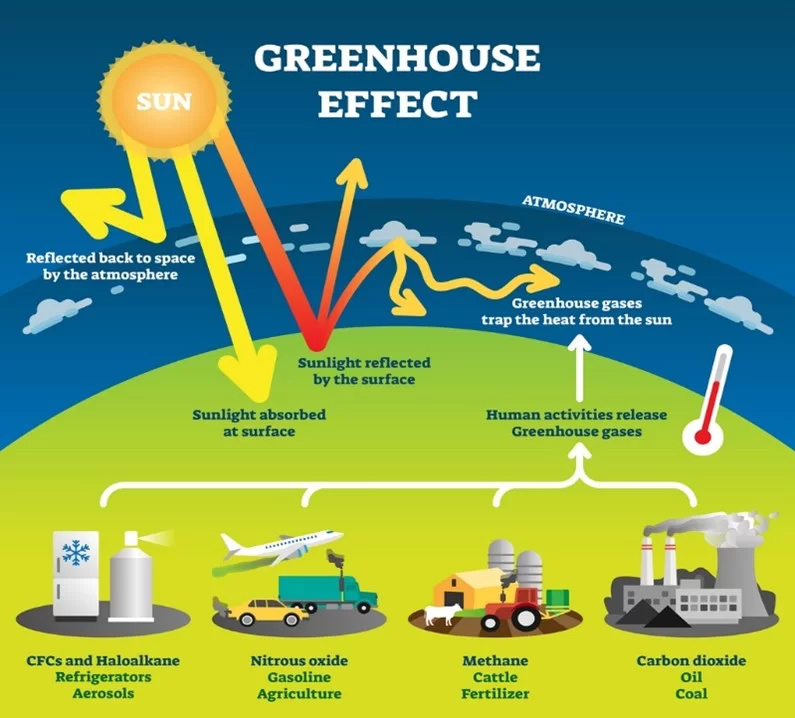Green House
I vividly remember a snowy winter morning when a family friend invited us for breakfast. Upon entering their house, we were ushered into a glass room, providing a unique experience for me. It was transparent, allowing us to see the outdoor activities, yet it was warm without any visible heating accessories. Curious, I asked, “What is this place?”
The host explained that “ it is a greenhouse or a glass house, which traps sunlight and remains warm due to the sun’s heat.
It is primarily used during winter seasons”. I wondered why it was called a greenhouse, not another colour house.
A greenhouse is a building with glass walls and a glass roof primarily used to grow ‘greens’, i.e. plants such as tomatoes and tropical flowers.
This concept of a greenhouse is not new. As documented in historical records, ancient Egyptians practiced this technique to grow non-seasonal plants.
Green House Effect
As you might expect from the name, the greenhouse effect works like a greenhouse!
A greenhouse remains warm inside even during winter. During daylight, the sun’s rays penetrate the greenhouse, warming the plants and air inside. At night time, the temperature outside drops, but the greenhouse remains relatively warm inside.
This is because greenhouse walls trap the heat received from the sun during day time.
Similarly, the greenhouse effect works on Earth. Gases such as carbon dioxide (CO2) present in the atmosphere act as greenhouse gases, functioning akin to the glass wall and ceiling of a greenhouse by trapping heat. During the day, the sun’s rays penetrate the atmosphere, heating the Earth’s surface. At night, the Earth’s surface cools, and it releases heat back into the air. However, some of the heat is trapped by the greenhouse gases in the atmosphere, which keeps our planet warm and comfortable at an average temperature of 58 degrees Fahrenheit (14 degrees Celsius).
Green House Gases
Greenhouse gases are gases present in the Earth’s atmosphere that trap heat. Without them, our planet would be too cold, and life as we know it would not exist. They are named after greenhouses as they work similarly. Greenhouse gases allow the sunlight to enter the Earth’s atmosphere, but they prevent the heat that comes with the sunlight from escaping.
The National Aeronautics and Space Administration (NASA) has observed increased carbon dioxide and other greenhouse gases in the atmosphere. Excessive amounts of these gases can cause the atmosphere to trap more heat, leading to global warming and various catastrophic situations worldwide.
Each gas has its potential to absorb energy or heat. Furthermore, each gas has its time to stay in the atmosphere. The Global Warming Potential (GWP) measures how much energy a gas can absorb over a given period, usually 100 years, compared to one tonne of carbon dioxide emission (CO2). Gases with higher GWP values trap more energy per tonne emitted in a given period of time, making them more dangerous to the environment. In other words, a higher GWP means that the gas contributes more to global warming.
The primary greenhouse gases include:
Water vapour (H2O)
Carbon dioxide (CO2)
Methane (CH4)
Nitrous oxide (N2O)
Chlorofluorocarbons (CFC)
Other fluorinated gases and haloalkanes such as hydrofluorocarbons (HFC), perfluorocarbon (CF4, C2F6, etc), sulphur hexafluoride (SF6) and nitrogen trifluoride (NF3)
I reached out to Dr Jane Koh, an ecologist and a chemical engineer, about the chemical composition of greenhouse gases and their impact to the environment. She pointed out, “some greenhouse gases are naturally occurring, but their concentration in the atmosphere has been increasing due to human activities, resulting in observable warming effect. Other greenhouse gases are synthesized by human, and can be avoided”.
Water Vapor (H2O)
In its gas form, water vapour is the most abundant greenhouse gas on the earth. It is responsible for approximately 50% of the Earth’s greenhouse effect. It condenses into liquid form and falls back to the earth as rain. This natural cycle of water is responsible for the water we drink. The concentration of atmospheric vapour varies greatly depending on temperature, ranging from less than 0.01% in frigid (cold) regions to 3% in saturated air at around 32°C.
Carbon Dioxide (CO2)
CO2 is naturally present in the atmosphere as part of the Earth’s carbon cycle. The carbon cycle is the natural circulation of carbon atoms among the atmosphere, oceans, soil, plants, and animals. However, human activities disrupt the carbon cycle by reducing natural carbon sinks and adding more CO2 to the atmosphere. Carbon sinks such as forests and soils are crucial in removing and storing CO2 from the atmosphere. While CO2 emissions may come from various natural sources, human-related (‘anthropogenic’) emissions from the burning of fossil fuels and biomass, etc., are responsible for the increased levels of CO2 in the atmosphere since the Industrial Revolution. CO2 stays in the atmosphere for a long time, between 300 to 1,000 years.
Due to its higher atmospheric concentration than other greenhouse gases and its rate of increase, the negative impact of increasing CO2 emission on the environment is significant. The global warming impact of CO2 over 100 years is used as the benchmark for Global Warming Potential (GWP). GWP100-year of CO2 is equal to 1. The unit of measurement for greenhouse gas is standardised as “tonne of CO2 equivalent (tCO2e)”, which means a quantity of greenhouse gas with GWP100-year equivalent to a tonne (1,000 kg) of CO2. When an emission or emission reduction is reported as “xx tCO2e” or erroneously as “xx tonne carbon”, it does not necessary means the emission is CO2. It could be other greenhouse gases.
Methane (CH4)
Methane gas is composed of carbon and hydrogen. It is typically released from wetlands, rice plantations, cattle farms, natural gas usage, and coal mining. Natural processes operating in soil and chemical reactions in the atmosphere help to decrease the amount of CH4 in the atmosphere. Methane
remains in the atmosphere for 12 years, a shorter period than carbon dioxide (CO2), but it is more effective at trapping heat than CO2. Over 100 years, the impact of CH4 is 28 times greater than CO2.
Nitrous Oxide (N2O)
Human activities such as agriculture, fuel combustion, wastewater management,
and industrial processes contribute to increased N2O in the atmosphere. Nitrous oxide is also naturally present in the atmosphere as a part of the Earth’s nitrogen cycle and has various natural sources.
Nitrous oxide molecules remain in the atmosphere for an average of 121 years before being eliminated by a sink or destroyed through chemical reactions. The warming impact of 1 tonne of N2O is 265 times greater than that of 1 tonne of carbon dioxide.
Chlorofluorocarbons (CFCs)
Chlorofluorocarbons (CFCs) are mainly used as refrigerants. They are ozone layer depleting substances and powerful greenhouse gases. The use of CFC has greatly reduced since the 1990s as a result of a concerted global effort called ‘Montreal Protocol’ that entered into force in 1989. CFCs have been replaced by other fluorinated gases, some of which, unfortunately, has even higher Global Warming Potenial (GWP) than CFCs, which GWP is more than 4,000 times that of CO2.
Other fluorinated gases
There are four main categories of fluorinated gases—hydrofluorocarbons (HFCs), perfluorocarbons (PFCs), sulfur hexafluoride (SF6), and nitrogen trifluoride (NF3). Fluorinated gases are primarily emitted through human activities. They are used as alternatives to ozone-depleting substances like CFCs and are also generated during various industrial processes such as aluminum and semiconductor manufacturing. Due to their high global warming potentials (GWPs) compared to other greenhouse gases, even minute atmospheric concentrations of fluorinated gases can significantly impact global temperatures. Additionally, they can persist in the atmosphere for thousands of years. It’s worth noting that fluorinated gases are mostly man-made and have no significant natural sources.
Conclusion
Greenhouse gases are good for the environment in certain aspects. However, excessive concentrations of greenhouses due to human activities are causing changes in Earth’s
natural greenhouse effect. Burning fossil fuels such as coal and oil releases more greenhouse gases into the atmosphere.
So, what can be done to solve this problem? Like a glass greenhouse, Earth’s greenhouse is full of plants that can help
balance the greenhouse effect. All plants, from giant trees to tiny phytoplankton in the ocean, absorb carbon dioxide and release oxygen, thus neutralising or limiting the greenhouse effect. This highlights the importance of finding and adopting nature-based solutions to mitigate or minimise the impact of climate change.
In the next article, I will invite Dr Jane Koh, who is the director of Southridge Malaysia – a carbon project developer – to co-author about emission reduction pathways that include nature-based solutions.


Tarikh Input: 27/03/2024 | Kemaskini: 27/03/2024 | lanz
PERKONGSIAN MEDIA

































